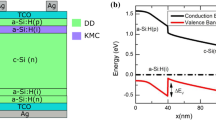Abstract
A self-consistent drift–diffusion simulator coupled with the Poisson equation is developed for amorphous Si p–i–n solar cells. By employing the principle of detailed balance, the present simulator takes into account the nonequilibrium distribution functions for the trap states in the mobility-gap in a self-consistent way so that the treatment of the capture–emission processes are expected to be physically more reliable. We then investigate the physical mechanism of the capture and emission processes under photoillumination: how the trap states in the mobility-gap affect the current–voltage characteristics under p–i–n structures. It is shown that the trap states near the band-edges have much stronger impact on both the device characteristics and the conversion efficiency of photovoltaic devices, compared to those in the middle of the mobility-gap.









Similar content being viewed by others
References
Sorensen, B.: Renewable energy: a technical overview. Energy Policy 19(4), 386–391 (1991)
Kurokawa, K.: Areal evolution of PV systems. Sol. Energy Mater. Sol. Cell 47, 27–36 (1997)
Matsui, T., Kondo, M.: Advanced materials processing for high-efficiency thin-film silicon solar cells. Sol. Energy Mater. Sol. Cell 119, 156–162 (2013)
Kamikawa-Shimizu, Y., Komaki, H., Yamada, A., Ishizuka, S., Iioka, M., Higuchi, H., Takano, M., Matsubara, K., Shibata, H., Niki, S.: Highly efficient Cu(In, Ga)S\({\rm e}_{2}\) thin-film submodule fabricated using a three-stage process. Appl. Phys. Express 6, 112303 (2013)
Repins, I., Contreras, M.A., Egaas, B., DeHart, C., Scharf, J., Perkins, C.L., To, B., Noufi, R.: 19.9%-efficient ZnO/CdS/CuInGaS\({\rm e}_{2}\) solar cell with 81.2% fill factor. Prog. Photovolt. Res. Appl. 16, 235–239 (2008)
Jackson, P., Hariskos, D., Lotter, E., Paetel, S., Wuerz, R., Menner, R., Wischmann, W., Powalla, M.: New world record efficiency for Cu(In, Ga)S\({\rm e}_{2}\) thin-film solar cells beyond 20%. Prog. Photovolt. Res. Appl. 19, 894–897 (2011)
Taguchi, M., Yano, A., Tohoda, S., Matsuyama, K., Nakamura, Y., Nishiwaki, T., Fujita, K., Maruyama, E.: 24.7% record efficiency HIT solar cell on thin silicon wafer. IEEE J. Photovolt. 4(1), 96–99 (2014)
Shockley, W., Read, W.T.: Statistics of the recombinations of holes and electrons. Phys. Rev. 87(5), 835–842 (1952)
Simmons, J.G., Taylor, G.W.: Nonequilibrium steady-state statistics and associated effects for insulators and semiconductors containing an arbitrary distribution of traps. Phys. Rev. B 4(2), 502–511 (1971)
Taylor, G.W.: Comments on ‘Surface-state density by photovoltage measurements-II’. J. Phys. D 5, 52–54 (1972)
Taylor, G.W., Simmons, J.G.: Basic equations for statistics, recombination processes, and photoconductivity in amorphous insulators and semiconductors. J. Noncryst. Solids 8–10, 940–946 (1972)
Simmons, J.G., Taylor, G.W.: The theory of photoconductivity in defect insulators containing discrete trap levels. J. Phys. C 8, 3353–3359 (1975)
Tiedje, T., Rose, A.: A physical interpretation of dispersive transport in disordered semiconductors. Solid State Commun. 37(1), 49–52 (1980)
Hack, M., Shur, M.: Theoretical modeling of amorphous silicon-based alloy p-i-n solar cells. J. Appl. Phys. 54, 5858–5863 (1983)
Hack, M., Guha, S., Shur, M.: Photoconductivity and recombination in amorphous silicon alloys. Phys. Rev. B 30(12), 6991–6999 (1984)
Hack, M., Shur, M.: Physics of amorphous silicon alloy p-i-n solar cells. J. Appl. Phys. 58, 997–1020 (1985)
Hack, M., Shur, M.: Analysis of lightinduced degradation in amorphous silicon alloy p-i-n solar cells. J. Appl. Phys. 58, 1656–1661 (1985)
Fantoni, A., Vieria, H., Martins, R.: Simulation of hydrogenated amorphous and microcrystalline silicon optoelectronic devices. Math. Comput. Simul. 49, 381–401 (1999)
Fantoni, A., Vieria, H., Martins, R.: Influence of the intrinsic layer characteristics on a-Si:H p-i-n solar cell performance analysed by means of a computer simulation. Sol. Energy Mater. Sol. Cell 73, 151–162 (2002)
Scharfetter, H.K., Gummel, H.K.: Large-signal analysis of a silicon read diode oscillator. IEEE Trans. Electron Dev. ED–16(1), 64–77 (1969)
Schropp, R.E.I., Zeman, M.: Amorphous and Microcrystalline Silicon Solar Cells. Kluwer, Norwell (1998)
Nelson, J.: The Physics of Solar Cells. Imperial College Press, London (2003)
Selberherr, S.: Analysis and Simulation of Semiconductor Devices. Springer, Wien (1984)
Turner, G.B., Schwartz, R.J., Park, J.W., Gary, J.L.: Recombination in thin film Si:H p-i-n solar cells. J. Noncryst. Solids 97&98, 1307–1310 (1987)
Nawaz, M.: Computer analysis of thin-film amorphous silicon heterojunction solar cells. J. Phys. D 44, 145105(13pp) (2011)
Walker, P.H., Uno, S., Mizuta, H.: Simulation study of the dependence of submicron polysilicon thin-film transistor output characteristics on grain boundary position. Jpn. J. Appl. Phys. 44(12), 8322–8328 (2005)
Lin, A.S., Wang, W., Phillips, J.D.: Model for intermediate band solar cells incorporating carrier transport and recombination. J. Appl. Phys. 105, 064512 (2009)
Lin, A.S., Phillips, J.D.: Drift-diffusion modeling for impurity photovoltaic devices. IEEE Trans. Electron Dev. 56(12), 3168–3174 (2009)
Acknowledgments
The authors would like to thank Shuta Honda and Akiko Ueda for the discussion during the course of this study. This work was supported in part by the Ministry of Education, Science, Sports, and Culture under Grant-in-Aid for Scientific Research (B) (No. 15H03983).
Author information
Authors and Affiliations
Corresponding author
Rights and permissions
About this article
Cite this article
Suzuki, A., Yoshida, K. & Sano, N. Self-consistent device simulation of a-Si p–i–n solar cells and energy resolution analyses of capture and emission processes. J Comput Electron 15, 1554–1562 (2016). https://doi.org/10.1007/s10825-016-0915-1
Published:
Issue Date:
DOI: https://doi.org/10.1007/s10825-016-0915-1




